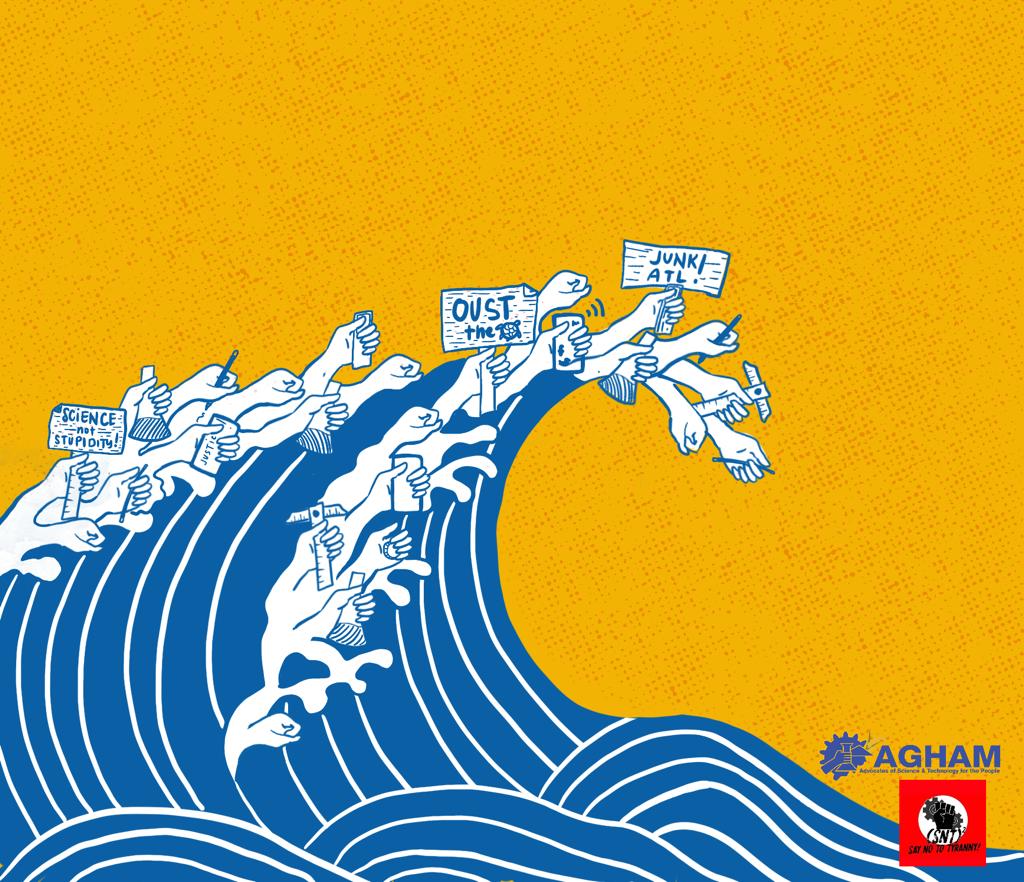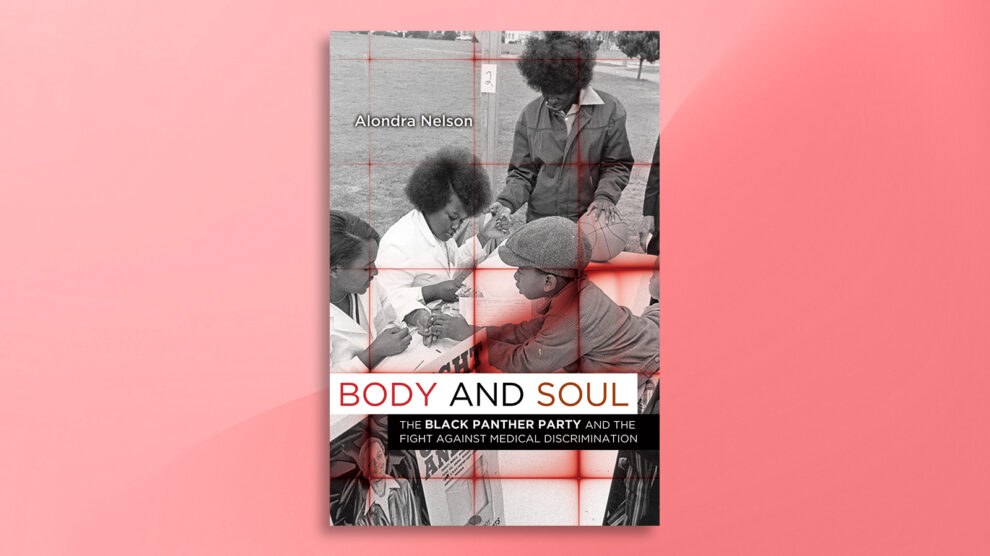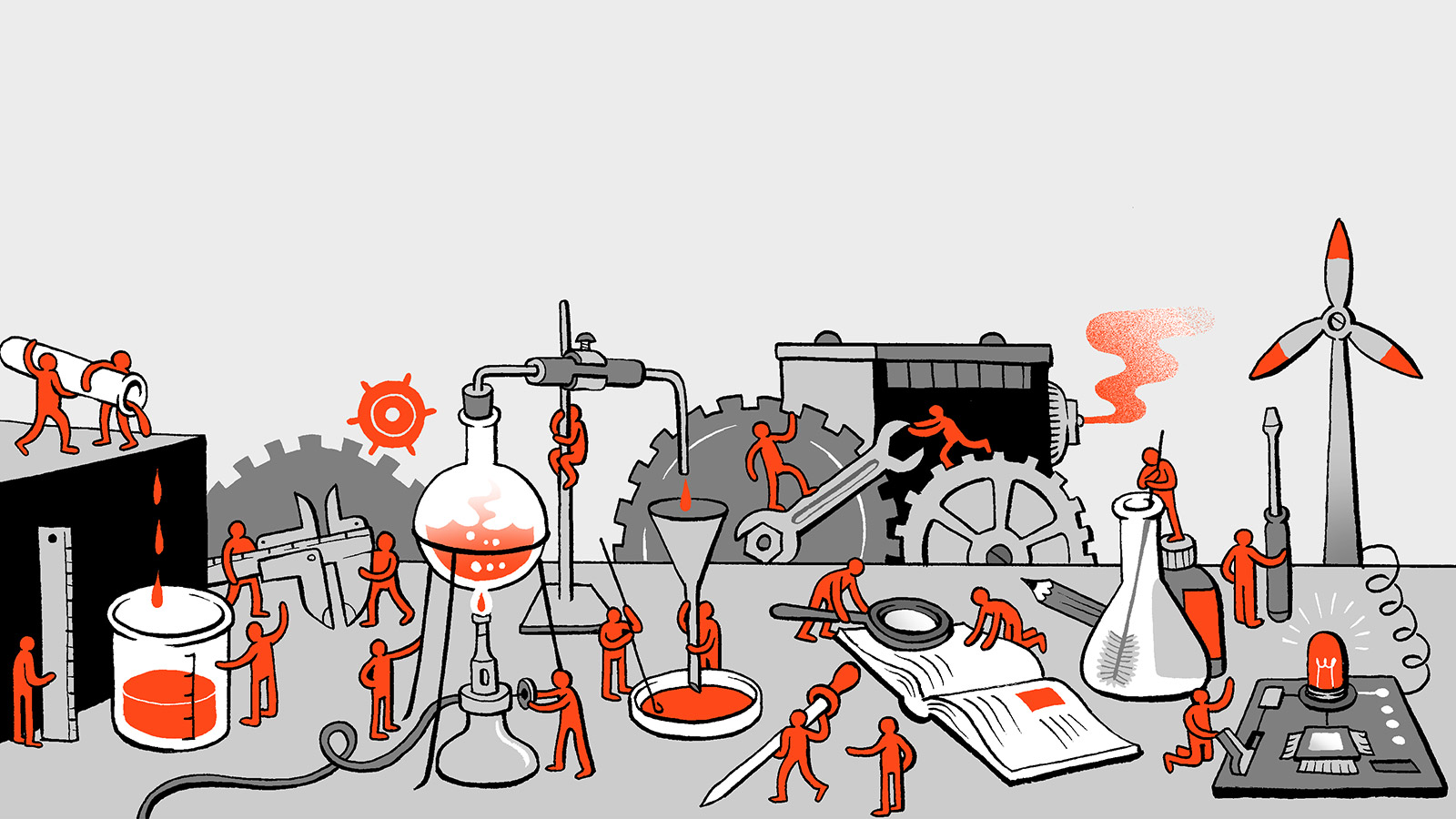Floods, Fascism, and Big Pharma
US Imperialism in the Philippine Neo-Colonies
By AGHAM
Volume 24, Number 1, Racial Capitalism
July 16, 2021
The Philippines and the United States have held a tumultuous relationship in the past 124 years. After defeating Spain in 1898 and gaining possession of the Philippine colony, the United States crushed a nascent Filipino liberation movement seeking self-determination in a war that left at least 250,000 civilians dead from the period of 1898 to 1902.1 Having cemented its colonial rule, they spent 48 years molding the Philippine government, economy, and culture in its image and likeness.
Since then, the United States has institutionalized police and intelligence units to defeat the revolutionary movement. The United States has used the Philippine Constabulary (PC) as the state’s instrument of repression. The PC was the origin of the current police force, the Philippine National Police, that was founded in 1901 during the time that the country was under US colonial rule. Using the PC for the state’s counterinsurgency program, it employed information technology and other intelligence strategies to defeat Filipinos fighting for national liberation.2
Seventy-five years after the sham independence, the Philippines continues to be a sacrificial lamb of the US imperial agenda. As we delve deeper into the two nations’ neocolonial connections, we will explore three aspects of neocolonialism between the Philippines in the periphery and its relation to the United States at the imperial center that have exacted deleterious consequences upon the Philippines and its people. These aspects are exemplified in three overarching themes of floods (natural disasters), fascism (authoritarianism and militarization), and Big Pharma (privatization of healthcare and research).
Philippine Floods and US Fossil Fuels
In 2013, Typhoon Haiyan inundated the eastern midsection of the country and killed at least 6,300.3 Another strong typhoon hit the country in November 2020 named Typhoon Goni. It battered the Bicol region, gaining distinction as the “strongest landfalling tropical cyclone” on record with 195 mph winds.4
These events reveal how highly vulnerable the Philippines is to the impacts of climate change. Owing to its location in the western Pacific typhoon belt and along the circum-Pacific seismic belt, about 74 percent of Filipinos of the 100 million population of the country are vulnerable to multiple hazards brought about by natural disasters and impacts of climate change. The vulnerability of the country from the impacts of climate change has been exacerbated by the carbon emissions of rich countries.
In the Philippines, the Commission on Human Rights has declared that forty-seven coal, gas, and oil companies, mainly from the US and UK, must be held accountable for the pollution they brought to our country that impacts the lives of our people. This was only after human rights and environmental groups filed a petition to investigate the contribution of big companies to carbon emissions. Due to climate change, this incessant environmental pollution will ultimately result in rising sea levels that can submerge between 6.9 to 13 million Filipino lives by 2100.5
The overseas investment of the United States is enormous in our country’s energy industry.
Asia has more than doubled its coal imports from the US from 2016 to 2017 and can be seen as Asia’s continuing dependence on coal for its economic growth.6 We are now confronting a climate emergency that may reach its tipping point. This is the point when the earth system has gone into an abrupt or irreversible damage and human intervention is deemed futile to slow down the global climatic threat.
The Philippines is among the countries that are recipients of dirty energy projects funded by International Financial Institutions (IFIs) such as the World Bank, Asian Development Bank (ADB), the Asian Infrastructure Investment Bank, and within the private sector arm of the World Bank, the International Finance Corporations. Among those projects are the privatization and refurbishment of the Calaca Coal-Fired Thermal Power Plant Project and the operation of the Mariveles coal plant extension. While there is a recognition of the climate vulnerability of developing countries brought about by the coal-fired technology, the IFIs and its financial networks are unstoppable in investing in fossil fuel technology worth five billion dollars in the ten Asian countries categorized under the Climate Vulnerable Forum (CVF). Countries under CVF are presently staging opposition against coal in the need for climate action.7
What has more so determined the fate of the energy sector of the country is the privatization of the energy industry.
In the Philippines, President Rodrigo Duterte has thrown his weight behind “clean coal technology” with its promise of high efficiency and low emission of toxic gases. And in the list of the energy projects of national significance as of August 2020, “clean coal power plants” included 3,738 megawatt to be generated by “clean coal.”8 As a greenwashing strategy to demonstrate that they are veering away from dirty energy projects, coal corporations have used these modified coal plants to justify the continuous use of coal energy.
However, this does not dissuade the fact that coal-fired plants will remain in the country and would contribute to worsening global warming. The United States has a stake in dirty energy projects as the ADB is a strategic asset for their economic expansion in Asia. In 2016, about 34 percent of the Philippines’s total installed power capacity was sourced from coal, supplying 48 percent of the actual electricity production. What has more so determined the fate of the energy sector of the country is the privatization of the energy industry. With the passage of the 2001 Electric Power Industry Reform Act, the way was paved for the staggering rise of electricity costs, placing the country among the highest in electricity rates of $0.20 per kWh as of October 2019.9 The energy privatization permitted corporations to determine the kind of energy resources to develop that would serve their profit-driven interests rather than the interests of consumers at a high price. From its direct colonial rule to semicolonial influence, US imperialism has ensured its stronghold of the Philippines in its control of our strategic industry such as the energy sector.

COVID-19, Big Pharma, and Brain Drain
Not only is US imperialism impacting the wellness of the environment, but it has also inundated the health and wellness of the people. The Philippines’s health system is patterned after the American privatized healthcare model that has been corporatized under the guise of improving its efficiency. In actuality, it has created inequality in access to health care.
Following the wave of neoliberalization in the late 1970s, public healthcare budgets dropped drastically and ushered in healthcare privatization. At the time, the stagnation of economic growth in the West as well as high inflation propelled these neoliberal policies forward, ensuring that businesses gained profit through financial deregulation at the expense of social and public services.
At present, the Philippines remains as one of the most COVID-19-struck countries in the world. As of March of 2021, it has recorded more than half a million confirmed cases and 12,694 deaths, ranking second in Southeast Asia.10 As of March 20, a record-high was reached with 7,999 new cases and thirty deaths in just a day.11 Its capacity to address the pandemic is seriously undermined by its inherently weak public health system as it is dominated by private health entities that are profit-driven rather than being service-oriented.
The COVID-19 pandemic has underscored not only the failings of the Philippines’s American-style privatized healthcare system, but also those of an underdeveloped national health and science research sector. Before COVID-19 struck, the IBON Foundation cited national data emphasizing under-resourcing and reduced capacity of the country to manage a health crisis with an average of one public-sector doctor for every 33,000 Filipinos and one public-sector nurse for every 50,000 citizens. Sixty-five percent of the country’s 1,236 hospitals are privately owned and are the primary beneficiaries of an insurance-based healthcare system. This explains why the health services become inaccessible to a greater populace as the hospitalization becomes horrendously expensive.
In January 2020, when the first cases started to appear in the country, samples had to be sent to Australia for testing.12 By March, it became critical that Filipinos be massively tested to contain the disease, yet there were only 2,000 virus testing kits at hand and 250 people tested per day.13 The lack of test kits and reagents—aside from sufficient testing labs, equipment, and trained personnel during the crucial first months of the pandemic—made effective containment impossible. Despite local efforts for developing a cheaper test kit, the country remained mostly reliant on imported kits, protective equipment, and other medical supplies. As the COVID-19 vaccine started its rollout in the various parts of the country, the Philippines is still scrambling from its vaccination program having been the last to receive the vaccine in Southeast Asia despite having one of the highest case counts in the region.
The lack of capacity to provide the basic necessity of an accessible and effective healthcare system can be traced back to the historical development of the Philippine society. Specifically, we need to focus on how US colonizers have robbed us of our means of production to establish our own manufacturing base on top of a self-reliant agricultural sector in order to address global pandemic and climate crises. Even leading economists like Ha-Joon Chang and Ilene Grabel have opposed the “consensus” that there is no alternative for neoliberal economic policies. They have shown that there is another path for the promotion of economic development that is “equitable, stable and sustainable” to reclaim development.14
The merits of having a homegrown productive manufacturing base would be acutely felt. However, in order for the imperial core countries to thrive, they need dumping grounds for surplus products, easy sources of cheap labor, and raw materials to ensure profits. Thus the industrial development of the Philippines, like most neo-colonies, has been thwarted by imperialism. Imperialism, as a global expression of capitalism, has reduced colonies to their natural resources, as mere factors of production and menial human labor. In the end they are made to serve their colonial masters, or whoever dominates the global economy—presently the United States. The country’s brightest scientific minds become apparatuses of Western imperialism due to the intentional stunting of homegrown manufacturing capability and consequently, research and development in the Philippines. It comes as no surprise that we rank 87th in the Research and Development sub-pillar of the World Economic Forum’s 2019 Global Competitiveness Report and that the government spends a paltry 0.16 percent of GDP for R&D in 2015.15
The lack of industrial development in the country has created a situation wherein there are limited domestic employment opportunities. As a result, many Filipino scientists opt to seek higher studies and employment abroad for greater opportunity to apply their knowledge and skills. Like most overseas workers, they are forced to leave their homes to uplift the conditions of their families. In 2013 alone, nearly 27,000 Filipinos classified as scientists and technologists (S&Ts) migrated overseas as Filipino workers.16 Against a historical backdrop of white colonial supremacy, the United States, the United Kingdom, Canada, and Australia are the top destinations for Filipino S&Ts. Unfortunately, these are also places where Filipino S&Ts endure discrimination, racism, and xenophobia for the sake of their livelihoods.
Imperialism, as a global expression of capitalism, has reduced colonies to their natural resources, as mere factors of production and menial human labor.
US imperialism benefits from the underdevelopment of poorer countries’ industrial, research, and health sectors. It ensures the US interests through aggressive assertion of neoliberal policies, captures markets for its surplus products, and it also gets to set price points favorable to the capitalist class. No one has been more responsible for the pandemic and its impacts on peoples but the system that operates healthcare for profit.

Duterte and the US Military Machine
While US imperialism is taking a stronghold on our national resources and assets, it also continues to control our military policies. Strategically situated in the western Pacific as a gateway to East Asia, US imperialism also has strategic interests in the South China Sea.
Thirty-five percent of the world’s maritime trade passes through this disputed maritime territory, and it contains billions of barrels of oil and trillions of natural gas cubic meters.17 While permanent US military bases no longer exist, security agreements ensure that US troops can dock, resupply, train at will on Filipino soil, and act as a deterrent to China.
Despite all outward appearances of shifting favor to China and threats against the United States, the Duterte administration continues to be a US war machine apparatus.
The imperialist US continues to relentlessly pursue its “strategic pivot” to Asia. The Philippines is a host of US military exercises that involve joint military drills and trainings on Philippine territory. Bilateral security agreements continue to be firmly in place that effectively maintain US troops and equipment on Philippine waters and soil, namely the 1951 Mutual Defense Treaty, 1998 Visiting Forces Agreement, 2002 Mutual Logistics and Support Agreement, and the 2014 Enhanced Defense Cooperation Agreement.18 The United States is also exerting its influence on its economic affairs through unequal trade relations such as the Trans-Pacific Partnership and other mega free trade agreements. Additionally, they assert their dominance on the cultural aspect by influencing the educational system, such as the K to 12 reform, an economic imposition, through neoliberal education reforms in the guise of making developing countries “competitive.”19
The state forces in the Philippines are instrumental in maintaining the so-called orderliness and security. This is a front for their being used to preserve a repressive regime by thwarting defiance at the grassroots. The country’s state armed forces—the Philippine National Police (PNP) and the Armed Forces of the Philippines (AFP) and their training centers, the PNP Academy and the Philippine Military Academy—have roots in the American occupation. The PNP’s precursor, the Philippine Constabulary, was established to assist American troops in crushing insurgents during the Philippine-American war.20 The AFP was established and trained by General Douglas MacArthur in 1935. These two forces were closely related to the development of the U.S. and Philippine counterinsurgency (COIN) and were responsible for employing brutal strategies such as waterboarding during the Philippine-American war. These tactics were a result of training received by the Philippines’s top military brass schooled in US military centers.21 The former first invoking brutal COIN strategies such as waterboarding during the Philippine-American war, and the latter adopting the U.S. COIN strategy to its local programs. Thousands of Filipinos across generations have enlisted and continue to enroll in the US Navy.
Despite Duterte’s rising unpopularity and human rights violations, the United States continues to support him. As of 2020, the United States has poured military aid to the Philippines through the $685 million intended for armaments.22 In 2017 alone, a total of 629 US arsenals were granted to the Philippine military to push for their counterinsurgency policies.23 These killing machines were used to bomb communities and schools where activism was present, notably in Mindanao, Northern Samar, and Negros provinces.24
Duterte has even chided the US that it should pay more in order to prevent the abrogation of the Visiting Forces Agreement (VFA). The VFA is the procedural guideline on the US military intervention in the country.25 Apart from this counterinsurgency policy, Duterte’s 2016 “War on Drugs” has resulted in 8,663 deaths alongside the death of 248 activists slain due to their political beliefs.26
As a striking lesson of imperialism coming home to roost, the armaments that have historically been dumped into the imperial periphery for profits, such as the Philippines and Yemen in the present moment (and captured by iconic scandals such as the Iran-Contra affair) are making their way into the hands of active shooters at US schools. It is this overproduction of armaments in the hyper-industrialized “defense” sectors in the West and its search for further profits that perpetuate needless lives lost, both in the periphery and the center.
The effects of ever-escalating militarization at the global periphery experienced by neocolonial nations like the Philippines can also be seen at the US imperial center with the ever advancing deadliness of their domestic police force.
In the Philippines, the violence against perceived critics of the government are expected to escalate with the upcoming 2022 national elections and the recently signed Anti-Terrorism Act of 2020.27 The effects of ever-escalating militarization at the global periphery experienced by neocolonial nations like the Philippines can also be seen at the US imperial center with the ever advancing deadliness of their domestic police force. Advanced warfighting gear and weaponry are becoming all the more ever-present in local police forces as they buy more surplus at discount rates from their military forces to maintain private property rights in evermore segregated US cities. The continuously increasing brutality of their own police tactics have just become available for the world to see through the prevalence of camera phone captures that have incited the righteous rage of their own citizenry in the same way the Filipino people respond to our own state repression. The Black Lives Matter movement in the United States in many ways reflects the Filipinx liberation movement.
Floods, Fascism, Big Pharma, and Its Roots in US Empire
Floods, fascism, and Big Pharma have one thing in common: they are facilitated by US capital’s unquenchable thirst for profits.
The US hegemony continues to debilitate the Philippines through its systematic and continuous subjugation that maintains US imperialism through neocolonial and neoliberal policies. It has manifested itself from massive carbon emissions accumulated over centuries of fossil fuel-driven overproduction and half a century of capitalist plundering of basic social services to the multibillion-dollar, military-industrial, and financial complexes that drive fascist regimes to wield weapons and tech against the people.
In the Philippines, scientists have linked arms with other affected and marginalized sectors in society to call for radical changes in our economic, political, and social systems rooted in American colonialism. We have denounced the US wars on “terror” and the national government’s penchant for warmongering and military spending. Meanwhile, public social service spending is cut, and many Filipinos fall deeper into poverty and vulnerability, most especially now as the pandemic rages. Even as we are met with harassment, vilification, red-baiting, and terrorist tagging, we recognize that we need to stand with the most affected sectors in Philippine society to pressure the government and affect meaningful if not radical change.
We ask the peoples of the world to be united in exposing and resisting US imperialism and its agenda of conquest and control. This, in the end, is what we believe science for the people truly signifies.
About the Authors
AGHAM (Advocates of Science and Technology for the People), are an organization of volunteer scientists, technologists, engineers and other science advocates based in the Philippines working to make science and technology serve the people. Their advocacy revolves around five major themes: environment, food security and self-sufficiency, public utilities, scientific and mass culture and national industrialization.
References
- D. H. Smith, “American Atrocities in the Philippines: Some New Evidence,” Pacific Historical Review 55, no. 2 (May 1, 1986): 281–83.
- Alfred W. McCoy, Policing America’s Empire: The United States, the Philippines, and the Rise of the Surveillance State (University of Wisconsin Press, 2009).
- “2013 State of the Climate: Record-Breaking Super Typhoon Haiyan,” accessed March 28, 2021, https://www.climate.gov/news-features/understanding-climate/2013-state-climate-record-breaking-super-typhoon-haiyan.
- Climate Nexus, “Climate Signals,” November 22, 2020, https://www.climatesignals.org/headlines/super-typhoon-goni-slams-philippines-strongest-landfalling-tropical-cyclone-record.
- Gaea Katreena Cabico, “In 30 Years, Rising Seas Will Threaten Philippine Cities, Towns Home to 6.8 Million,” The Philippine Star, November 6, 2019, https://www.philstar.com/headlines/2019/11/06/1966508/30-years-rising-seas-will-threaten-philippine-cities-towns-home-68m.
- U.S. Energy Information Administration,“U.S. Coal Exports Increased by 61% in 2017 as Exports to Asia More than Doubled,” accessed March 28, 2021, https://www.eia.gov/todayinenergy/detail.php?id=35852.
- “Greenpeace: Climate Emergency Demands Action, and COP24 Must Deliver Ambition,” accessed March 28, 2021, https://www.greenpeace.org/international/press-release/19867/greenpeace-climate-emergency-demands-action-and-cop24-must-deliver-ambition.
- “399 Applications Accepted for National Energy Projects,” The Manila Times, September 1, 2020, https://www.manilatimes.net/2020/09/01/business/business-top/399-applications-accepted-for-national-energy-projects/761977/.
- “Renewables May Cut Philippines’ Electricity Rates 30%,” accessed March 28, 2021, https://asian-power.com/power-utility/news/renewables-may-cut-philippines-electricity-rates-30.
- “Philippines Reports Highest Daily Rise in COVID-19 Cases in Almost Six Months,” Reuters, March 12, 2021, https://www.reuters.com/article/us-health-coronavirus-philippines-cases-idUKKBN2B40U9.
- Asean Briefing and Dezan Shira & Associates, “COVID-19 Vaccine Roll Outs in ASEAN & Asia – Live Updates by Country,” March 27, 2021, https://www.aseanbriefing.com/news/covid-19-vaccine-roll-outs-in-asean-asia-live-updates-by-country/.
- Edna M. Edrada et al., “First COVID-19 Infections in the Philippines: A Case Report,” Tropical Medicine and Health 48 (April 14, 2020): 21.
- Prinz Magtulis, “With Only 250 People Tested a Day, Philippine Health Sector Appears Ill-Prepared for COVID-19,” The Philippine Star, March 9, 2020, https://www.philstar.com/business/2020/03/09/1999444/only-250-people-tested-day-philippine-health-sector-appears-ill-prepared-covid-19.
- Ha-Joon Chang and Ilene Grabel, Reclaiming Development: An Economic Policy Handbook for Activists and Policymakers (Zed Books, 2004).
- “Competitiveness Rankings,” accessed March 28, 2021, World Economic Forum, https://wef.ch/2m6QorX.
- Department of Science and Technology, Science Education Institute, Republic of the Philippines, “Migration of S&T Human Resources: Permanent and Temporary Migrants,” accessed March 28, 2021, https://www.sei.dost.gov.ph/index.php/programs-and-projects/research/90-migration-of-s-t-human-resources-permanent-and-temporary-migrants.
- U.S. Energy Information Administration, “South China Sea,” accessed March 28, 2021, https://www.eia.gov/international/analysis/regions-of-interest/South_China_Sea.
- “Visiting Forces Agreement,” accessed March 28, 2021, https://www.lawphil.net/international/treaties/vfa_1998.html; U.S. Embassy Manila, “Mutual Logistics Support Agreement Archives,” accessed March 28, 2021, https://ph.usembassy.gov/tag/mutual-logistics-support-agreement/.
- Arthur S. Abulencia, “The Unraveling of K-12 Program as an Education Reform in the Philippines,” SIPATAHOENAN 1, no. 2 (2015), https://doi.org/10.2121/sip.v1i2.689.
- Carl Thayer, “Analyzing the US-Philippines Enhanced Defense Cooperation Agreement,” accessed March 28, 2021, https://thediplomat.com/2014/05/analyzing-the-us-philippines-enhanced-defense-cooperation-agreement/.
- U.S. Embassy Manila, “U.S. and Philippine Special Forces Train to Counter Insurgency,” February 27, 2020, https://ph.usembassy.gov/us-and-philippine-special-forces-train-to-counter-insurgency/.
- “Philippines Receives $29 Million of Military Equipment from U.S. to Boost Defences,” Reuters, December 8, 2020, https://www.reuters.com/article/philippines-usa-security-idUSKBN28I1MP.
- U.S. Embassy Manila, “U.S. Military Presents New Weapons and Equipment to Philippine Marine Corps Commandant for Counterterror Fight,” June 5, 2017, https://ph.usembassy.gov/us-military-presents-new-weapons-equipment-philippine-marine-corps-commandant-counterterror-fight/.
- Bulatlat, “800,000 Rights Abuses Recorded in 2 Years of Martial Law in Mindanao,” May 25, 2019, https://www.bulatlat.com/2019/05/25/800000-rights-abuses-recorded-in-2-years-of-martial-law-in-mindanao-rights-group/; “Aerial Bombings, Intensified Attacks on Peasant Communities in Northern Samar, Blamed on Duterte’s MO 32,” Anakpawis, October 31, 2019, https://anakpawis.net/2019/10/aerial-bombings-intensified-attacks-on-peasant-communities-in-northern-samar-blamed-on-dutertes-mo-32/; “Negros Oriental Bloodshed: State-Sponsored or Insurgency-Related?,” Rappler, August 27, 2019, https://www.rappler.com/newsbreak/in-depth/negros-oriental-bloodshed-state-sponsored-or-insurgency-related.
- Center for Strategic and International Studies, “What Is the Philippines-United States Visiting Forces Agreement, and Why Does It Matter?,” accessed March 28, 2021, https://www.csis.org/analysis/what-philippines-united-states-visiting-forces-agreement-and-why-does-it-matter.
- United Nations High Commissioner for Human Rights, “Situation of Human Rights in the Philippines,” accessed March 28, 2021, https://www.ohchr.org/EN/NewsEvents/Pages/DisplayNews.aspx?NewsID=25924.
- Julie McCarthy, “Why Rights Groups Worry About The Philippines’ New Anti-Terrorism Law,” NPR, July 21, 2020, https://www.npr.org/2020/07/21/893019057/why-rights-groups-worry-about-the-philippines-new-anti-terrorism-law.





